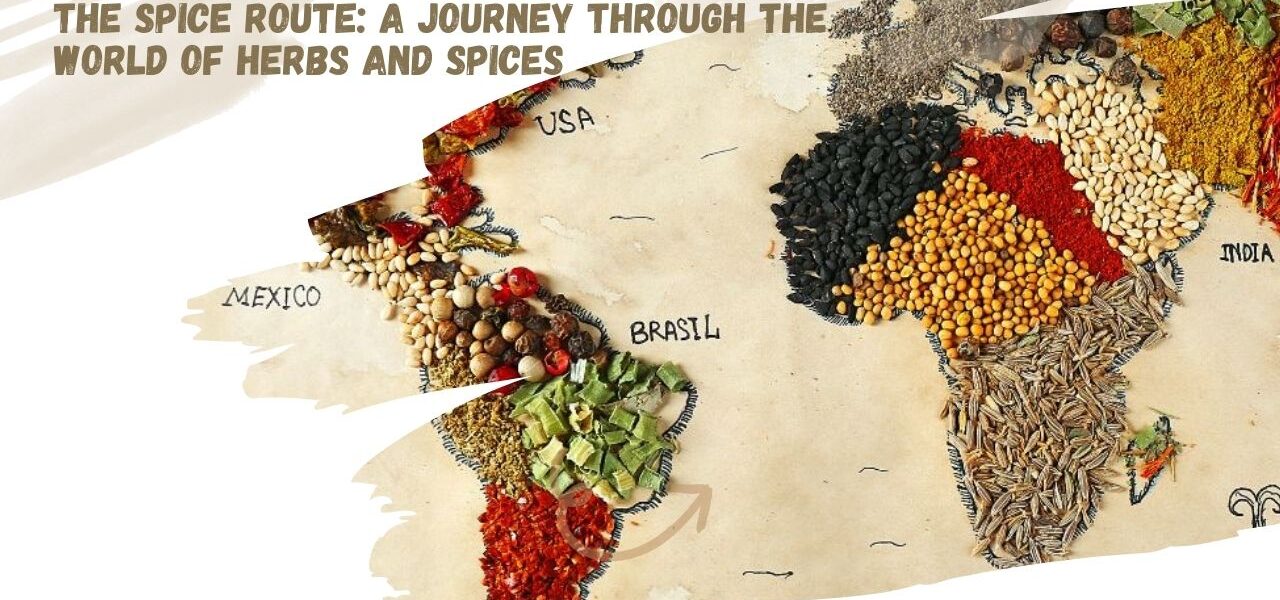The Spice Route, a vast network of ancient trade routes connecting the East and the West, was more than just a commercial pathway; it was a conduit for the exchange of goods, ideas, culture, and knowledge. Spices like cinnamon, pepper, cloves, and nutmeg were so valuable that they shaped economies, influenced exploration, and even caused wars. These aromatic treasures were not only prized for their culinary uses but also revered for their medicinal and preservative qualities.
In this blog, we’ll embark on a fascinating journey through the history of the Spice Route, exploring the origins, uses, and captivating stories behind some of the world’s most beloved herbs and spices. From ancient times to modern kitchens, these spices have left an indelible mark on human civilization.
The Historical Significance of the Spice Route
The Beginnings of the Spice Trade
The Spice Route dates back to as early as 2000 BCE, when spices were transported from Asia to Europe. Ancient civilizations, including the Egyptians, Mesopotamians, and Romans, prized spices for their flavor, fragrance, and medicinal properties. Spices like cinnamon, cardamom, and ginger were highly sought after and used in religious rituals, embalming processes, and culinary traditions.
The trade of these spices was initially facilitated by land routes such as the Silk Road, but as maritime technology advanced, sea routes through the Indian Ocean became the primary channels for spice transportation. Arab traders played a crucial role in transporting spices from India, Sri Lanka, and Southeast Asia to the Mediterranean and beyond. This trade not only enriched the coffers of merchants but also facilitated cultural and intellectual exchanges between distant lands.
A Catalyst for Global Exploration
The desire for direct access to spices was one of the driving forces behind the European Age of Exploration. In the 15th and 16th centuries, explorers like Vasco da Gama and Christopher Columbus set out to find new routes to the spice-rich lands of Asia, circumventing the Arab and Venetian middlemen who dominated the trade. This pursuit of spices led to the discovery of new continents, the establishment of colonial empires, and the creation of modern trade routes.
The Rise of Colonial Empires
The spice trade was so lucrative that European powers like Portugal, Spain, the Netherlands, and Britain fought fiercely to control spice-producing regions in Asia. The Portuguese established a foothold in India and Sri Lanka, while the Dutch East India Company dominated the spice trade in Indonesia, particularly the Maluku Islands, also known as the “Spice Islands.” These colonial empires exploited native populations and natural resources, leaving a legacy of both cultural exchange and exploitation.
Key Spices of the Spice Route
Throughout history, several key spices were traded along the Spice Route, each with its own unique story and significance.
1. Cinnamon
Origin: Native to Sri Lanka and southern India.
Uses: Cinnamon is used in a variety of sweet and savory dishes, from desserts and baked goods to curries and beverages. It also has anti-inflammatory and antioxidant properties that have been utilized in traditional medicine for centuries.
Historical Tidbit: In ancient Egypt, cinnamon was highly valued and used in the embalming process for preserving mummies. It was considered more valuable than gold at times.
2. Pepper
Origin: Native to the Malabar Coast of India.
Uses: Often referred to as the “King of Spices,” pepper enhances the flavor of countless dishes around the world, from meats and vegetables to soups and sauces.
Historical Tidbit: During the Roman Empire, pepper was so valuable that it was used as currency. Roman soldiers were sometimes paid in peppercorns, and the spice was a luxury reserved for the elite.
3. Cloves
Origin: Native to the Maluku Islands (Spice Islands) in Indonesia.
Uses: Cloves are used in both culinary and medicinal contexts. Their warm, aromatic flavor enhances baked goods, marinades, and beverages. In traditional medicine, cloves are known for their antiseptic properties and are often used to relieve toothaches.
Historical Tidbit: During the Middle Ages, cloves were so expensive that they were often worth their weight in gold. The Dutch East India Company established a monopoly on the clove trade, which led to fierce competition and conflict with other European powers.
4. Nutmeg
Origin: Native to the Banda Islands in Indonesia.
Uses: Nutmeg is used in both sweet and savory dishes, adding warmth and depth to desserts, sauces, and beverages like eggnog. It is also believed to aid digestion and improve sleep.
Historical Tidbit: The British and Dutch fought fiercely for control of the Banda Islands due to the immense value of the nutmeg trade. At one point, the Dutch traded the island of Manhattan to the British in exchange for control over the Banda Islands and their nutmeg production.
The Journey of Spices: From Asia to Europe
Overland and Maritime Routes
Spices embarked on perilous journeys from Asia to Europe, traversing both land and sea. Overland routes passed through the Middle East, where Arab traders would transport the precious cargo to Mediterranean ports. Once there, the spices were distributed to European markets, where they were eagerly consumed by the wealthy.
Maritime routes, however, offered faster and more direct access to spice-rich regions. Arab, Indian, and Southeast Asian sailors navigated the Indian Ocean, bringing spices to ports in the Arabian Peninsula, Egypt, and eventually Europe.
The Role of Arab Traders
Arab traders were instrumental in the early spice trade, acting as middlemen between Asia and Europe. Their knowledge of the monsoon winds and sea routes allowed them to dominate the spice trade for centuries. They established trading hubs in cities like Baghdad, Cairo, and Alexandria, from which spices were transported across the Mediterranean and beyond.
Culinary and Medicinal Uses of Spices
Culinary Uses of Herbs and Spices
Herbs and spices have been integral to global cuisines for centuries, imparting flavor, aroma, and even medicinal properties to dishes. The culinary applications of these botanicals vary widely depending on the culture, cuisine, and even specific dishes. Let’s explore the diverse ways in which herbs and spices are utilized in cooking.
1. Flavor Enhancers
The primary use of herbs and spices is to enhance the flavor of food. A sprinkle of cumin can transform a simple curry, while a pinch of oregano adds an authentic Mediterranean touch to pizza and pasta. These ingredients can be used fresh or dried, and their flavors can range from sweet and floral to sharp and pungent. Popular examples include:
- Basil – Common in Italian cuisine, it adds sweetness to tomato-based dishes like marinara sauce.
- Thyme – Often used in French cooking, thyme brings a subtle earthy flavor to stews, soups, and roasted vegetables.
- Cinnamon – Known for its warm, sweet taste, it’s used in both sweet dishes like apple pie and savory dishes like Moroccan tagines.
2. Marinades and Rubs
Herbs and spices are frequently used in marinades and rubs for meats, fish, and vegetables. Marinades, often containing a mix of spices, herbs, and oils, help tenderize proteins while infusing them with complex flavors. Rubs, typically dry blends, are applied directly to the surface of meats to create a crust as they cook.
- Garlic, rosemary, and lemon are a classic marinade for lamb.
- Paprika, cumin, and chili powder make a great rub for grilled meats or vegetables.
3. Seasoning
Seasoning dishes with herbs and spices is key to balancing flavors. A dish without seasoning can taste bland or one-dimensional, whereas a properly seasoned dish will have depth and character.
- Salt and pepper are the most basic seasoning agents, but herbs like parsley, cilantro, and dill are frequently added at the end of cooking to give freshness.
- Turmeric and ginger are common in Indian and Southeast Asian seasoning blends, adding warmth and complexity.
4. Pickling and Preserving
Spices such as mustard seeds, cloves, and bay leaves play a crucial role in the preservation of foods. In pickling, they are added to vinegar solutions to preserve vegetables while imbuing them with vibrant, tangy flavors. Pickled cucumbers, onions, and cabbage often rely on this method.
5. Infusions
Herbs and spices are often used to create infused oils, vinegars, and even beverages like tea. Infusions capture the essence of the ingredient, releasing flavors slowly over time.
- Basil and rosemary oils can be drizzled over salads or used in cooking.
- Chamomile and mint make calming herbal teas, often consumed for their medicinal benefits.
6. Cultural Dishes
Different regions of the world have developed iconic dishes that heavily rely on the use of specific herbs and spices:
- India: Known for its diverse use of spices like turmeric, cumin, and coriander in curries and lentil dishes.
- Mexico: Spices like cumin, chili powder, and oregano are staples in tacos, enchiladas, and mole sauces.
- Middle East: Herbs like mint and parsley are commonly used in fresh salads like tabbouleh, while spices like sumac and za’atar add tanginess and depth to flatbreads and meats.
7. Desserts
Many people don’t realize that spices play an essential role in desserts. Cinnamon, cardamom, nutmeg, and cloves are frequently used in baked goods and sweet dishes around the world.
- Apple pie, cinnamon rolls, and gingerbread all rely on these warming spices to create comfort food classics.
- Saffron and cardamom are often used in Middle Eastern and Indian sweets, adding a rich, aromatic flavor.
8. Beverages
Herbs and spices also feature prominently in beverages. In addition to their use in teas, they can be used to flavor cocktails, punches, and traditional drinks. For example:
- Cinnamon and star anise are often used in mulled wine and spiced cider.
- Mint is a popular ingredient in cocktails like mojitos and non-alcoholic drinks like lemonade.
9. Healthy Cooking
In recent years, herbs and spices have gained recognition for their health benefits. They’re used in cooking as a means to reduce the need for added fats, sugars, and salt while still delivering robust flavor. For instance:
- Turmeric is prized for its anti-inflammatory properties and is added to smoothies, soups, and stews.
- Ginger aids digestion and is commonly used in stir-fries and soups.
Herbs and spices provide a kaleidoscope of flavors that bring life to dishes across the world. Whether they’re used to create bold marinades, elevate humble vegetables, or transform desserts into aromatic delights, their versatility in the kitchen is endless.
Final Thoughts: The Spice Journey
The journey through the world of herbs and spices is one filled with history, culture, and culinary discovery. From ancient spice routes to modern kitchen shelves, these botanical wonders have transcended time and geography to become essential ingredients in every cook’s arsenal.
Each herb and spice carries with it a story — a unique flavor profile, a cultural significance, or a health benefit that has stood the test of time. Whether you’re exploring the zesty kick of chili peppers in Mexican cuisine, savoring the earthiness of cumin in Indian dishes, or indulging in the sweet warmth of cinnamon in your favorite dessert, herbs and spices remind us that the art of cooking is truly universal.
So the next time you’re in the kitchen, think of the spice route that has brought these treasures from far-off lands to your table. Experiment with new flavors, and embrace the endless possibilities that these fragrant gems offer in your culinary journey.




